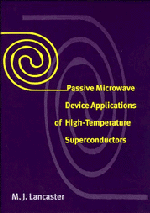Book contents
- Frontmatter
- Contents
- Preface
- Acknowledgements
- 1 Superconductivity at microwave frequencies
- 2 Superconducting transmission lines
- 3 Superconducting cavity resonators
- 4 Microwave measurements
- 5 Superconducting filters
- 6 Superconducting delay lines
- 7 Superconducting antennas
- 8 Signal processing systems
- Appendix 1 The surface impedance of HTS materials
- Appendix 2 Substrates for superconductors
- Appendix 3 Some useful relations
- Index
5 - Superconducting filters
Published online by Cambridge University Press: 14 September 2009
- Frontmatter
- Contents
- Preface
- Acknowledgements
- 1 Superconductivity at microwave frequencies
- 2 Superconducting transmission lines
- 3 Superconducting cavity resonators
- 4 Microwave measurements
- 5 Superconducting filters
- 6 Superconducting delay lines
- 7 Superconducting antennas
- 8 Signal processing systems
- Appendix 1 The surface impedance of HTS materials
- Appendix 2 Substrates for superconductors
- Appendix 3 Some useful relations
- Index
Summary
Introduction
This chapter discusses the use of superconductors in the construction of microwave filters. Superconductors can help in two ways. Firstly, the performance of a filter is improved by the use of superconductors in the sense that the insertion loss can be significantly reduced, as well as improving the filter roll off and reducing its bandwidth. Secondly, filters can be miniaturised. The improvement in the performance of filters is generally achieved by using fairly conventional design techniques, and improvement arises due to the reduced dissipation owing to the low surface resistance. However, miniaturisation usually requires a change in the geometry of filters and therefore entirely new types of filter become possible when superconducting materials are used in their construction. Improved performance and miniaturisation are complementary and reducing the size of a filter generally leads to reduced performance, although superconductors allow a much larger reduction in size, when compared with normal metals, whilst still giving improved performance. A third possible reason for using superconductors is to use their special properties such as the change in internal (or kinetic) inductance with microwave power or temperature, or to use their switching capabilities. These functions are discussed further later in this chapter. This chapter is organised under the theme of miniaturisation, where most of the interesting novel work has been in HTS filter development. All the filters discussed, especially those only having a modest amount of miniaturisation, are superior in performance to conventional filters made from normal metals.
- Type
- Chapter
- Information
- Publisher: Cambridge University PressPrint publication year: 1997



